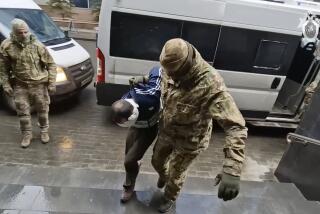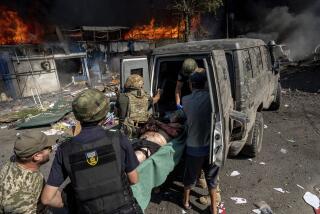Muslim Unrest Grows Inside the Soviet Union
- Share via
SANTA MONICA — Muslims rioted inside the Soviet Union during mid-December. The prompt Soviet reporting of unrest at Alma-Ata, in Central Asia, following the replacement of the local Kazakh party boss with a Russian official, seemed to the West another remarkable manifestation of Mikhail S. Gorbachev’s campaign for glasnost --openness--and an example of the difficulties facing his struggle against corruption and nepotism.
But subsequent details reveal that glasnost and corruption were, at most, side shows to a violent outburst of anti-Russian and anti-Soviet resentment among Soviet Muslims. After two days of rioting by some 10,000 young Muslims, the regime was able to stabilize the situation. Yet there is real significance in the events at Alma-Ata. The replacement of Dinmukhamed Kunaev and the ensuing riot are symptomatic of a growing conflict between the regime and the Muslims, one that could prove an intractable problem for Kremlin leadership.
The trouble comes from a combination of powerful long-term trends and Gorbachev’s own recent policies in predominantly Muslim areas. The best-known trend is a continuing demographic shift--enlarging the non-European, particularly Muslim, population of the Soviet Union. Representation of Muslims among the available labor force and the military pool has increased dramatically. Most of the surplus laborers and nearly one-third of the conscript pool are Muslims, although Muslims make up only about 20% of the population overall. Perhaps more important, explosive Muslim birth rates in regions such as Central Asia, are in contrast with a rapidly shrinking Russian and Slavic population that has provided the bulk of the quasi-colonial elites. In 1970, the Slavic population of Central Asia numbered about 21% of the total; today it is about 13% and decreasing. Moreover, a large majority of Muslims live in small towns and rural areas that are ethnically and culturally homogeneous, where efforts to inculcate them in the regime’s value system have proved ineffective.
The demographic gains have been accompanied by two other important and closely-related trends presenting a serious long-term threat to the Russian-dominated regime. First, the Islamic revival in Central Asia and elsewhere seems to have reached proportions unacceptable to Soviet authorities. After years of depicting Islam as a moribund remnant of the “feudal past,” Soviet officials have started presenting a much less sanguine picture. In Uzbekistan, a Pravda article noted, “a complicated religious situation has developed in recent years” and atheistic work to “oppose the teachings of Islam” was said to be unsatisfactory. A high official in Tadzhikistan complained that the number of believers and unauthorized mullahs is growing and noted that the clergy encourages “ugly varieties of regionalism and nationalism.” Similarly, in Kirgizia, a party official warned that propagators of Islam are strengthening their influence over women, young people and children. In that republic, a survey of religious attitudes among first-year university students indicated that 42% admitted to be practicing believers while another 38% were not aware of the “harmful influence” of religion. Throughout Central Asia, Islamic rites are reported to be widely observed and underground Islamic activities are spreading.
Authorities are clearly worried that the Islamic reawakening of Soviet Muslims could one day become the basis for a nationalist challenge to the regime. Remarkably, officials have also started admitting that Soviet Muslims may not be immune to international influences such as the war in Afghanistan or the spread of Islamic fundamentalism. “Without a doubt,” a Tajik functionary recently stated, “the activizing of Islam has been fostered to some degree by the circumstances surrounding the regional events of recent years in certain countries.”
No less troublesome for Moscow is growing evidence of a live-and-let-live attitude--perhaps even collusion--between Muslims in government and the people. In many cases, the party is not only failing to neutralize Islam, Islam may be co-opting the party. Such concerns were publicly raised at the party congresses of the Central Asian republics earlier this year. In speech after speech, party luminaries lambasted local officials for neglecting atheist indoctrination, for the “internationalist upbringing” of native youth and for having “allied themselves with Islam.” Party officials were accused of “hypocritical attitudes,” including having tolerated: underground Islamic organizations, production of illegal religious items in state enterprises and construction of facilities for Muslim pilgrims at local “holy places.”
At an October plenum session in Uzbekistan, party cadres were accused of having “reached a compromise with religion.” Islam’s inroads among indigenous communists was confirmed at the highest level when Gorbachev himself recently admonished an audience in Tashkent: “We must be strict above all with communists and senior officials, particularly those who say they defend our morality and ideals but in fact help promote backward views and themselves take part in religious ceremonies.”
In this light, Kunaev’s ouster gains special significance. Gorbachev evidently could not find a trusted local native and had to bring in a Russian functionary with no Kazakh experience. This heavy-handed approach has both damaged the carefully cultivated appearance of native control of local affairs and indicated the Kremlin’s deep unease.
But then, Gorbachev’s policies in Central Asia--even before the events in Alma-Ata and contrary to his benign image in the West--have been heavy-handed. They have surely contributed to a simmering Muslim resentment that found violent expression in the riots.
Since coming to power, and especially this year, Gorbachev purged Central Asian officials on a scale not seen since Josef Stalin. Under the slogan of struggling against corruption, regionalism and nepotism, more than half of all Central Committee members were dismissed in early 1986 in all republics. In Uzbekistan, 80% of Central Committee members and 90% of the candidate members were tossed out. These purges have been accompanied by an influx of Russian/Slavic cadres at the more senior levels and tightening of Moscow’s control. The Uzbek party Central Committee, for instance, is now numerically dominated by Russians, even though they make up less than 10% of the republic’s population.
Resentment has been intensified by another Gorbachev policy--the campaign against “unearned income” initiated last July. The Kremlin wants to destroy or severely curtail the vast network of private legal, semi-legal and illegal transactions known as the second economy. The effort is fraught with political danger because the second economy has served as an essential safety valve for popular frustrations over the system’s inability to provide needed goods and services. In Central Asia, especially, the second economy enables an acceptable standard of living and thus assures a degree of political acquiescence. Without the ability to augment income through the second economy, the local population would suffer an economic decline more serious than other areas. Despite rhetoric to the contrary, Central Asia continues to be treated as a colonial possession. As in Czarist times, the region is primarily an exporter of raw materials, with relatively little industrial development and a smaller share of investment resources. The area, for example, grows 90% of all Soviet cotton but produces only about 7% of cotton textiles. The per capita social expenditure in Central Asia is more than 30% lower than the Soviet average, and declining.
Finally, Gorbachev has ordered a frontal assault on Islam. For the past year, Soviet media have engaged in a virtual orgy of Islam-bashing. Thousands of propagandists have been sent to the countryside for atheistic work and “practical exercises to unmask the cunning and perfidy of the lackeys of religion.” Officials have sponsored “Atheism months” throughout Central Asia and have called for history texts to “show the negative consequences of the Arab conquest of Central Asia and the spread of Islam.” In lecture after lecture, the regime stresses that Islam and socialism are incompatible.
Kremlin concern is well-founded as growing numbers of the 50 million Soviet Muslims seem to realize that Soviet socialism may be ultimately incompatible with their spiritual, economic and political aspirations. The political implications of this trend do not bode well for the last surviving colonial empire.
More to Read
Sign up for Essential California
The most important California stories and recommendations in your inbox every morning.
You may occasionally receive promotional content from the Los Angeles Times.












